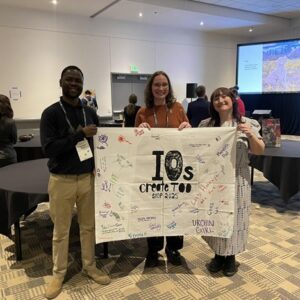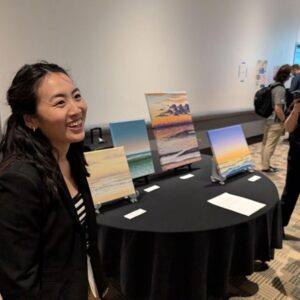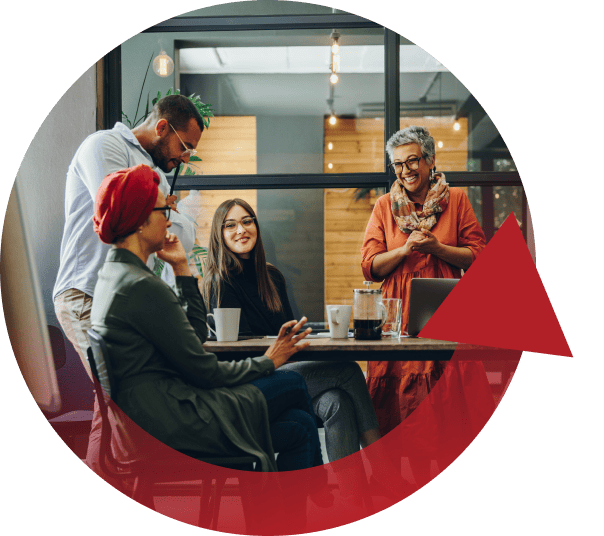The Society for Industrial and Organizational Psychology’s (SIOP) annual conference is a cornerstone event, traditionally emphasizing scientific rigor and evidence-based practice through presentations, posters, and panel discussions. Yet, within this demanding environment, there is a growing recognition of the need to support holistic professional experiences, including recovery, creativity, and well-being—elements increasingly vital in modern workplaces and professional gatherings.
 Responding to this need and aligning with initiatives like “Gentle SIOP,” the 2025 SIOP Conference introduced Workscapes, its first-ever art exhibit, offering a novel space for attendees. Amid the bustling conference schedule, Workscapes provided a unique sanctuary designed not only to showcase the creative talents of I-O psychologists but also to offer a crucial moment for pause, reflection, recovery, and connection, boldly declaring: I-Os create too.
Responding to this need and aligning with initiatives like “Gentle SIOP,” the 2025 SIOP Conference introduced Workscapes, its first-ever art exhibit, offering a novel space for attendees. Amid the bustling conference schedule, Workscapes provided a unique sanctuary designed not only to showcase the creative talents of I-O psychologists but also to offer a crucial moment for pause, reflection, recovery, and connection, boldly declaring: I-Os create too.
Why Recovery and Art Matter
The intensive nature of academic and professional conferences like SIOP can be demanding, often leading to cognitive overload and fatigue. The “Gentle SIOP” initiative, previously highlighted in SIOP communications (e.g., Cobb & Rauvola, 2024), signals SIOP’s commitment to fostering more inclusive, supportive, and well-being-focused experiences for its members. Workscapes serves as a practical manifestation of this commitment, directly addressing the need for recovery spaces within the conference setting itself.
Integrating art and creative engagement into traditional academic settings offers a powerful way to promote such recovery. Meijman and Mulder’s (1998) effort-recovery model suggests that recovery involves actively replenishing resources depleted by effortful tasks. Providing nontechnical, reflective spaces, such as an art exhibit, allows attendees to disengage from the cognitive demands of sessions and recharge. Research across disciplines supports this, demonstrating that art plays a role in promoting well-being, emotional regulation, and even cognitive function (Fancourt & Finn, 2019; Mundet-Bolos et al., 2017). Viewing art, even briefly, can stimulate positive effect, facilitate cognitive processing, and reduce stress (Trupp et al., 2024), making it a scalable way to enhance mental health within a busy conference environment.
Furthermore, creativity itself is a vital psychological resource, particularly relevant to I-O professionals who often engage in demanding knowledge work. Creativity enables flexible responses to stressors (Helzer & Kim, 2019) and thrives in environments that foster trust and psychological safety (Ohly, 2018). These elements are crucial for the health of professional communities, such as SIOP. Such communities, or communities of practice (CoPs), rely on both internal cohesion and external engagement to foster learning, identity, and innovation (Wenger, 1998). Creative spaces like Workscapes can nurture these CoPs by providing informal settings for connection and shared experience outside of formal sessions.
Finally, the concept of psychological detachment (i.e., mentally disengaging from work) is critical for preventing exhaustion and fostering sustained engagement (Sonnentag et al., 2010; Kilroy et al., 2020). A space like Workscapes offers attendees an opportunity for such detachment during the conference, helping to buffer against the intensity of back-to-back sessions and networking demands. Integrating art, creativity, and opportunities for recovery directly into the conference fabric acknowledges these needs and positions SIOP as a professional home that values the whole person.
Creative and Cognitive Pathways to Recovery
Understanding how recovery works further highlights the value of initiatives like Workscapes at SIOP. Recovery is not passive rest but an active process of resource replenishment (Sonnentag & Fritz, 2007). Key recovery experiences include psychological detachment (mentally switching off), relaxation (reduced arousal), mastery (learning or challenging oneself), and control (autonomy over one’s time). Although often studied in the context of after-work recovery, these principles apply equally to within-conference recovery needs.
Even brief respites during the workday (or conference day) can be effective if they involve low-effort or self-chosen activities, which prevent further resource depletion and restore emotional and cognitive capacity (Trougakos & Hideg, 2009). This aligns with the effort-recovery model (Meijman & Mulder, 1998), conservation of resources theory (Hobfoll, 1989; Hobfoll & Wells, 1998), and broaden-and-build theory (Fredrickson, 1998). In contrast, poorly managed demands, such as unproductive meetings or overwhelming conference schedules, can drain resources and increase stress.
Professional societies like SIOP have a role in mitigating burnout and supporting member well-being (Rinne et al., 2021). Initiatives like Workscapes represent an organizational-level intervention complementing individual coping strategies. Importantly, recovery is not just about low effort; pleasant activities, even if effortful, can aid recovery, highlighting the role of positive emotional experiences (Van Hooff et al., 2011). Creative activity, specifically, is linked to positive recovery experiences, such as relaxation, mastery, and control, and can indirectly enhance job performance through resource regeneration (Eschleman et al., 2014). Promoting engagement with the arts, as advocated in STEAM models (Land, 2013), fosters cognitive flexibility, emotional processing, and personal meaning—all of which contribute to resilience and well-being, making it a highly relevant addition to the SIOP conference.
Purpose and Process of SIOP’s First Art Exhibit: Workscapes
Workscapes was designed with several key purposes in mind:
- Provide a dedicated space for rest and recovery amid the conference intensity.
- Encourage participation in conference activities beyond traditional sessions, diversifying the attendee experience.
- Celebrate the multidimensionality of I-O psychologists and their often-hidden creative talents.
- Spark conversations about the intersection of creativity, art, well-being, and I-O psychology within the SIOP community.
- Offer a tangible expression of the “Gentle SIOP”
The creation of Workscapes involved proposing the novel concept to the SIOP Community of Interest Committee, recruiting I-O artists via social media, designing an interactive, collaborative art board (#IOsCreateToo) to encourage low-pressure engagement, curating the physical space, and creating a session program to feature the artists. As the first art-related session held at an annual SIOP conference, Workscapes offered a refreshing way for attendees to connect in a different way, whether they were deeply interested in the art–science intersection or simply seeking respite. The interactive board, drawing on principles of CoP engagement (Hoadley, 2012) and the value of creative spaces (i.e., a “freiraum,” or space for freedom; Auernhammer & Hall, 2014) allowed attendees to become active participants, reinforcing the theme of shared creativity within the profession.
Session Outcomes and Reactions: Validating the Need for Workscapes at SIOP
The inaugural Workscapes exhibit featured over 100 pieces across diverse media, including poetry, painting, pottery, crochet, collage, photography, and glass jewelry. The interactive #IOsCreateToo board garnered over 45 contributions, signifying active engagement.
A postsession survey was distributed to attendees to gather feedback (N = 27 attendees: 46% practitioners, 39% graduate students, 14% academics; diverse demographics represented). The data provide strong evidence of the exhibit’s purpose and impact within the SIOP context:
- Cognitive shift: Over 55% strongly agreed Workscapes prompted new thinking about the art/I-O intersection and affirmed creativity’s role in work recovery.
- Conversation starter: 78% reported it sparked important conversations relevant to work and well-being.
- Recovery value: 86% strongly agreed it provided a meaningful opportunity for relaxation and recovery during the conference.
- Positive experience: 92% strongly agreed it was engaging and positively contributed to their overall SIOP conference experience.
- Recommendation:3% would strongly recommend it to a colleague attending SIOP.
- Future demand: 100% expressed a desire for Workscapes to return at future SIOP conferences.
 Qualitative feedback echoed these findings. Attendees praised the “relaxed vibe,” the chance to see colleagues as “human beings with their own lives,” and the unique way it fostered connection, “very different[ly] than other conference activities.” The opportunity to meet artists and learn about their processes was frequently highlighted as a favorite aspect, inspiring connection and even ideas for workplace applications (e.g., “inspired me to consider how we can do something similar with our lab!”).
Qualitative feedback echoed these findings. Attendees praised the “relaxed vibe,” the chance to see colleagues as “human beings with their own lives,” and the unique way it fostered connection, “very different[ly] than other conference activities.” The opportunity to meet artists and learn about their processes was frequently highlighted as a favorite aspect, inspiring connection and even ideas for workplace applications (e.g., “inspired me to consider how we can do something similar with our lab!”).
Common themes in constructive feedback included the desire for
- Longer duration/better placement: Suggestions to display the art throughout the conference or schedule the session during breaks or lunch for easier access and mental rest. Current scheduling could unintentionally signal lower importance.
- Increased visibility/marketing: Calls for more promotion to attract both attendees and potential artist submissions.
- Expanded scope: Interest in more art, more artists, potentially larger spaces, and added elements like refreshments (“wine and cheese”) or more interactive/guided activities.
This feedback overwhelmingly underscores Workscapes’ value as a unique, restorative, and highly desired addition tailored explicitly to enhance the SIOP conference experience.
Lessons Learned and Next Steps for Workscapes at SIOP
Workscapes 2025 successfully demonstrated the SIOP community’s appetite for initiatives that integrate recovery, creativity, and well-being into the conference structure. It served as a powerful pilot, confirming that such spaces are not just welcomed but actively contribute to a more positive and holistic attendee experience, aligning perfectly with the “Gentle SIOP” philosophy.
Based on attendee feedback and the exhibit’s success, future iterations at SIOP could explore
- Broader calls for artist participation across SIOP memberships.
- Integration of structured creative workshops or guided reflection sessions.
- Securing a more central or larger location with longer viewing hours.
- Establishing recognition, such as a featured “Artist of the Year.”
- Incorporating diverse elements like live demonstrations, readings, or sensory enhancements (such as music and aromatherapy).
- Advocating for scheduling that emphasizes its role as a core part of the conference experience, not just an add-on.
Workscapes represent a meaningful step toward evolving the SIOP conference. We aim to build on this momentum, continuing to shape SIOP into a more inclusive, restorative, and creatively enriched professional home.
Suggested Future Readings for Attendees and Organizers
For those interested in further exploring the intersection of creativity, well-being, and professional life, the following resources offer valuable insights:
- Amabile, T. M. (1996). Creativity in Context.
- Bayles, D., & Orland, T. (1994). Art and Fear.
- Berger, J. (1972). Ways of Seeing.
- Bernes, J. (2017). The Work of Art in the Age of Deindustrialization.
- Cameron, J. (2016). The Artist’s Way.
- DeGraff, J., & Lawrence, K. A. (2002). Creativity at Work.
- Edwards, B. (1979). Drawing on the Right Side of the Brain.
- Gilbert, E. (2016). Big Magic: Creative Living Beyond Fear.
- Goins, J. (2015). The Art of Work: A Proven Path to Discovering What You Were Meant to Do.
- Gombrich, E. H. (1950). The Story of Art.
- Grant, A., & Sandberg, S. (2016). Originals: How Non-Conformists Move the World.
- Jacobson, M. (1997). Art for Work: The New Renaissance in Corporate Collecting.
- Kaufman, S. B., & Gregoire, C. (2015). Wired to Create: Unraveling the Mysteries of the Creative Mind.
- Magsamen, S., & Ross, I. (2023). Your Brain on Art: How the Arts Transform Us.
- Milliner, N. (2024). Art In the Workplace: Fostering Creativity and Innovation.
- Moss, A. (2024). The Work of Art: How Something Comes From Nothing.
- Nixon, N. (2020). Creativity Leap: Unleash Curiosity, Improvisation, and Intuition at Work.
- Pressfield, S. (2002). The War of Art: Break Through the Blocks and Win Your Inner Creative Battles.
- Rubin, R. (2023). The Creative Act: A Way of Being.
- Thornton, S. (2008). Seven Days in the Art World.
These readings can help continue the dialogue sparked by Workscapes within the I-O psychology community. Remember, I-Os create too.
Acknowledgments
We extend our sincere gratitude to Shanique Brown of the SIOP Community of Interest Committee, the SIOP Planning Committee, dedicated volunteers, the talented featured artists, and especially the attendees whose engagement and feedback made Workscapes 2025 a resounding success. Your enthusiasm inspires our continued efforts to foster a more inclusive, gentle, and artistically rich SIOP experience.
Featured Artists
- Elain Atay – University of Calgary
- Lora Bishop – DePaul University
- Colleen Cui – University of Central Florida
- Al DeMartino – OrgVitality
- Rhiannon Grodnik – Central Michigan University
- Jessica Hicksted – ND Visionary Partners
- Brittany Ikner – Wayne State University
- Derek Lusk – AIIR Consulting
- Ian Sideritis – North Carolina State University
- Emma Vosika, on behalf of CSIOP – Clemson University
References
Auernhammer, J., & Hall, H. (2014). Organizational culture in knowledge creation, creativity and innovation: Towards the Freiraum model. Journal of Information Science, 40(2), 154–166. https://doi.org/10.1177/0165551513508356
Cobb, H. R., & Rauvola, R. S. (2024). Gentle SIOP: A new conference approach. The Industrial-Organizational Psychologist, 61(4). https://www.siop.org/tip-article/gentle-siop-a-new-conference-approach/
Eschleman, K. J., Madsen, J., Alarcon, G., & Barelka, A. (2014). Benefiting from creative activity: The positive relationships between creative activity, recovery experiences, and performance‐related outcomes. Journal of Occupational and Organizational Psychology, 87(3), 579–598. https://doi.org/10.1111/joop.12064
Fancourt, D., & Finn, S. (2019). What is the evidence on the role of the arts in improving health and well-being? A scoping review (Health Evidence Network Synthesis Report No. 67). World Health Organization Regional Office for Europe.
Fredrickson, B. L. (1998). What good are positive emotions? Review of General Psychology, 2(3), 300–319. https://doi.org/10.1037/1089-2680.2.3.300
Helzer, E. G., & Kim, S. H. (2019). Creativity for workplace well-being. Academy of Management Perspectives, 33(2), 134–147. https://doi.org/10.5465/amp.2016.0141
Hoadley, C. (2012). What is a community of practice and how can we support it? In D. H. Jonassen & S. M. Land (Eds.), Theoretical foundations of learning environments (2nd ed., pp. 303–318). Routledge.
Hobfoll, S. E. (1989). Conservation of resources: A new attempt at conceptualizing stress. American Psychologist, 44(3), 513–524. https://doi.org/10.1037/0003-066X.44.3.513
Hobfoll, S. E., & Wells, J. D. (1998). Conservation of resources, stress, and aging: Why do some slide and some spring? In M. Duffy & B. G. Knight (Eds.), Handbook of aging and mental health: An integrative approach (pp. 121–134). Springer US.
Kilroy, S., Bosak, J., Flood, P. C., & Peccei, R. (2020). Time to recover: The moderating role of psychological detachment in the link between perceptions of high-involvement work practices and burnout. Journal of Business Research, 108, 52–61. https://doi.org/10.1016/j.jbusres.2019.10.012
Land, M. H. (2013). Full STEAM ahead: The benefits of integrating the arts into STEM. Procedia Computer Science, 20, 547–552. https://doi.org/10.1016/j.procs.2013.09.317
Meijman, T. F., & Mulder, G. (1998). Psychological aspects of workload. In P. J. D. Drenth, H. Thierry, & C. J. de Wolff (Eds.), Handbook of work and organizational psychology: Vol. 2. Work psychology (2nd ed., pp. 5–33). Psychology Press/Erlbaum (UK) Taylor & Francis.
Mundet-Bolos, A., Fuentes-Pelaez, N., & Pastor, C. (2017). A theoretical approach to the relationship between art and well-being. Revista de Cercetare si Interventie Sociala, 56, 133–146.
Ohly, S. (2018). Promoting creativity at work–Implications for scientific creativity. European Review, 26(S1), S91–S99. https://doi.org/10.1017/S1062798717000576
Rinne, S. T., Shah, T., Anderson, E., Delgado, S., Good, V., Sederstrom, N., Sheikh, T. L., Targoff, K., Tobin, D., Volerman, A., Wolfe, K., & Moss, M. (2021). Professional societies’ role in addressing member burnout and promoting well-being. Annals of the American Thoracic Society, 18(9), 1482–1489. https://doi.org/10.1513/AnnalsATS.202012-1506OC
Sonnentag, S., & Fritz, C. (2007). The Recovery Experience Questionnaire: Development and validation of a measure for assessing recuperation and unwinding from work. Journal of Occupational Health Psychology, 12(3), 204–221. https://doi.org/10.1037/1076-8998.12.3.204
Sonnentag, S., Kuttler, I., & Fritz, C. (2010). Job stressors, emotional exhaustion, and need for recovery: A multi-source study on the benefits of psychological detachment. Journal of Vocational Behavior, 76(3), 355–365. https://doi.org/10.1016/j.jvb.2009.06.005
Trougakos, J. P., & Hideg, I. (2009). Momentary work recovery: The role of within-day work breaks. In S. Sonnentag, P. L. Perrewé, & D. C. Ganster (Eds.), Current perspectives on job-stress recovery (Vol. 7, pp. 37–84). Emerald Group Publishing Limited. https://doi.org/10.1108/S1479-3555(2009)0000007005
Trupp, M. D., Howlin, C., Fekete, A., Kutsche, J., Fingerhut, J., & Pelowski, M. (2024). The impact of viewing art on well-being—A systematic review of the evidence base and suggested mechanisms. Journal of Positive Psychology, 19(2), 287–311. https://doi.org/10.1080/17439760.2025.2481041
Van Hooff, M. L., Geurts, S. A., Beckers, D. G., & Kompier, M. A. (2011). Daily recovery from work: The role of activities, effort and pleasure. Work & Stress, 25(1), 55–74. https://doi.org/10.1080/02678373.2011.570941
Wenger, E. (1998). Communities of practice: Learning as a social system. Systems Thinker, 9(5), 2–3.
Volume
63
Number
1
Author
Lora Bishop, Brittany Ikner, and Takudzwa A. Chawota
Topic
2025 Annual Conference

